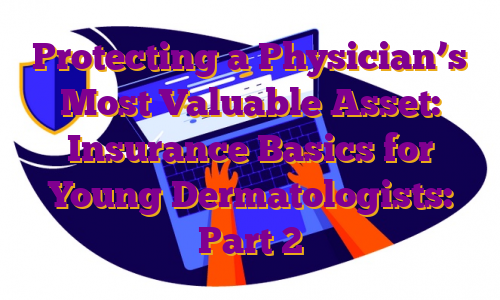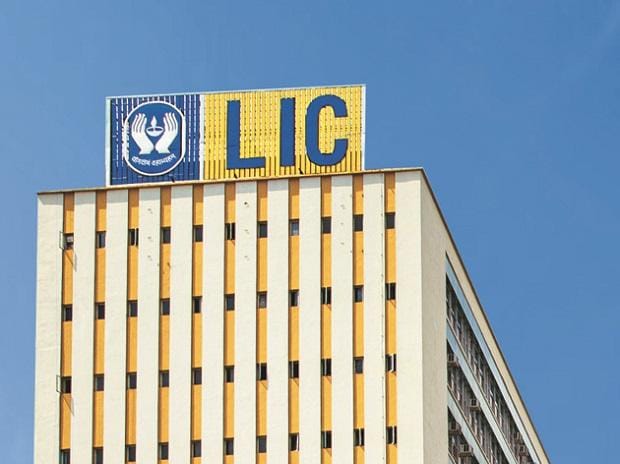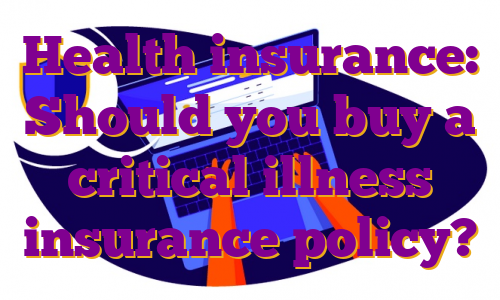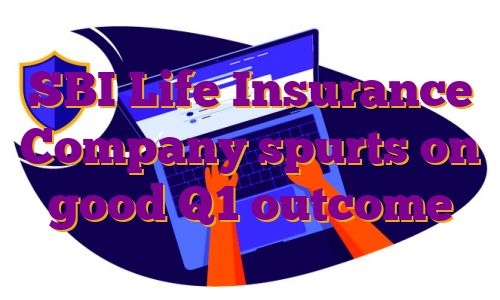The most valuable asset for nearly every dermatologist is their ability to practice their profession, as the future income stream from this asset is significant and quantifiable. To protect this asset for themselves and for others dependent on them, dermatologists rely on disability and life insurance as fundamental “asset protectors.” Young dermatologists should secure these tools early on in their careers, and established physicians should regularly review existing insurance policies to ensure they are maintaining necessary levels of protection.We covered disability insurance in Part 1 of this 2-part article (see the August issue of Dermatology Times®), and now we will focus on the basics physicians need to know about life insurance in Part 2.Term Life InsuranceA term life insurance policy pays a specific lump sum to your designated beneficiary upon your death. As such, it plays an important role in providing temporary income protection for your family (or practice/partners as part of a buy-sell arrangement). Given its affordability, term is the most common type of life insurance policy. The premium on a term policy is low compared with other types of life insurance policies because the term policy carries no cash value and provides protection for a limited period of time (referred to as a term; usually 5, 10, 15, or 20 years). Term policies work simply—you pay a premium each year, typically, and the policy pays out if you die within the term period. If not, there is no payment or accumulated value. The vast majority of term policies never pay out because the insured lives past the end of the term.Permanent Life InsuranceThe category of permanent life insurance comprises products that, unlike those of term policies, carry cash values along with death benefits and can last for the entirety of the insured’s life—to age 100, 115, or beyond. (Of course, these products are “permanent” only as long as the required premiums are paid on time.) Because there are several different products in the general category of permanent insurance, and they are more complex than term policies, we will cover them in more depth.One significant advantage of all permanent policies is that they enjoy tax-free growth of cash value and, if properly managed, tax-free access to the cash value. These tax benefits, along with asset protection in many states, is what attracts many dermatologists to permanent insurance.Although there are more than 5 major categories of permanent life insurance, we only have room here to describe 2. For more depth on this topic, see the “special offers” at the end of this article to request or download our free book. 1: Whole Life Insurance Whole life (WL) insurance pays a death benefit to the beneficiary you name and offers you a cash value account with tax-deferred cash accumulation.Pros: WL insurance has a savings element (cash value) that is tax deferred. The cash value grows based on the life insurance company paying a dividend. This dividend is determined by the life insurance company, is not guaranteed, and is likely to change annually. Because of the low interest–rate environment over the last 15 years, dividend rates on WL policies have been decreasing. You can borrow from this account free of income tax, or, if it is properly structured, you can cash in the policy during your lifetime. It has a fixed premium that can’t increase during your lifetime (as long as you pay the planned amount), and your premium is invested for you long term. Because it has the cash accumulation component, WL insurance can offer benefits such as tax reduction, wealth accumulation, asset protection, estate planning, and tax diversification of asset classes.Cons: WL insurance does not allow you to invest in separate accounts (eg, money market, stock, and bond funds). Thus, your policy’s returns will be tied to the life insurance company’s dividend credit based on that company’s underlying investments. It also does not allow you to split your money among different accounts or move your money between accounts, and it does not allow premium flexibility or face amount (the death benefit amount) flexibility.2: Equity-Indexed Universal Life Insurance Equity-indexed universal life (EIUL) insurance is a universal life policy (which has more premium and policy flexibility than a WL product) that allows you to select from a list of stock market indices to grow your cash value. If the investments fail, there is a guaranteed minimum death benefit paid to your beneficiary upon your death.EIUL insurance gives you more upside than a traditional universal life policy because the insurance company contractually agrees to credit the policy’s cash value with the same return as the stock market index the policy holder chooses (typically, the S&P 500 Index, but it can be the Dow, NASDAQ, or others) realized over the same period of time, subject to a cap and a floor. Thus, the policy owner has the upside of the indices (up to the cap) but the risk of the same indices (but only to the floor). Typical floors for an annual return begin at near 0% (no loss of principal), with caps around 10%.Pros: EIUL insurance enables you to get potentially more upside in the cash value accounts than WL but also gives you downside protection.Cons: Products are relatively complex, with many choices of indices, participation rates, floors, and caps, and they vary significantly from insurance carrier to insurance carrier. Working with a professional who can help you make good decisions about policy placement and annual management is essential.Is Permanent Life Insurance a “Good” Investment?When thinking about permanent life insurance, many dermatologists want to understand whether it is a “good” or “bad” investment. But how can permanent life insurance be a “good” or “bad” investment when the choices within permanent products are so broad and deep? In other words, the structure of a permanent life insurance policy allows for an almost limitless number of underlying investments within the structure, and those investments will provide the policy’s returns.As we explained, WL insurance offers a bond-based, dividends-type return. Is this good or bad? It depends on what the rest of the market does, doesn’t it? In 2008-09, an asset with such a return would likely have been the best-performing asset class on a physician’s balance sheet. For EIUL insurance, the performance of the policy is based on the owner’s choice of indices, which could work out extremely well—or not. The fact is, a permanent life policy can be a fantastic, great, good, fair, or poor investment because it isn’t an investment itself; rather, it’s a structure that houses investments, the choices of which are almost innumerable. Conclusion: Protecting Your Most Valuable Asset Throughout Your CareerAll physicians, including dermatologists, should review their disability and life insurance policies regularly throughout their careers to ensure they are maintaining adequate coverage for the most cost-effective premiums.An experienced insurance advisor can assist you in evaluating your options and selecting policies that fit your needs and long-term financial goals. The authors welcome your questions.Disclosure:OJM Group, LLC (“OJM”) is an SEC registered investment adviser with its principal place of practice in the State of Ohio. SEC registration does not constitute an endorsement of OJM by the SEC nor does it indicate that OJM has attained a particular level of skill or ability. OJM and its representatives are in compliance with the current notice filing and registration requirements imposed upon registered investment advisers by those states in which OJM maintains clients. OJM may only transact practice in those states in which it is registered or qualifies for an exemption or exclusion from registration requirements. For information pertaining to the registration status of OJM, please contact OJM or refer to the Investment Adviser Public Disclosure website www.adviserinfo.sec.gov.For additional information about OJM, including fees and services, send for our disclosure brochure as set forth on Form ADV using the contact information herein. Please read the disclosure statement carefully before you invest or send money.This article contains general information that is not suitable for everyone. The information contained herein should not be construed as personalized legal or tax advice, or as a recommendation of any particular security or strategy. There is no guarantee that the views and opinions expressed in this article will be appropriate for your particular circumstances. Tax law changes frequently; accordingly, information presented herein is subject to change without notice. You should seek professional tax and legal advice before implementing any strategy discussed herein.Wealth Planning for the Modern Physician and Wealth Management Made Simple are available free in print or e-book. Download by texting DERM to 844-418-1212. .
Surrendering a policy: When should you do it — and should you at all?
As the pandemic hit lives, the economy, and livelihoods, 2021-22 witnessed a sharp spike in insurance policies being surrendered ahead of their maturity. Data show that more than 2.3 crore life insurance policies were surrendered during the year — more than three times the number of policies (69.78 lakh) surrendered in 2020-21.
It is ironical that at a time when one is in desperate need of his/ her money, while surrendering a traditional policy (endowment or money back), policyholders in the majority of cases end up with a surrender value that is even lower than the premiums paid.
In case of unit-linked plans, it may result in lower returns on the capital investment. It is, therefore, very important to understand the pitfalls of surrendering, and to evaluate all options before you decide to do so.
What should you look for before surrendering your policy?
The first thing that one needs to check is the surrender value. “Often, people don’t check the surrender value, and assume that the current value of the policy is what they will get if they surrender. It is only later that they realise that what they have received is much less than the current value. So one must check the surrender value before taking the decision,” said Surya Bhatia, founder, AM Unicorn Professional.
Advisers say that policyholders must also evaluate the reason for surrendering the policy, and the various options they can explore with insurance companies. Individuals must look at the reason for surrender — whether they need the money or they think they can’t make future premium payments — and accordingly make their decision.
If one is looking to surrender the policy because they believe they can’t pay future premiums, the policyholder must reconsider.
“After you finish with the minimum period of paying premiums, you have the option to either surrender or stop paying further premiums. Very often this is referred to as paid-up status, where you stop paying the premium and the benefits of your policy reduce proportionately in line with the reduced payment period, Vishal Dhawan, founder, Plan Ahead Wealth Advisors, said.
“So,” he said, “if someone needs to control future cash flows, the individual must explore the paid-up option. Many a time, paid-up options are not looked at by people, and they think that they can either continue or surrender.”
If one is in need of money, one can consider taking a loan against the policy, if the requirement is for a temporary period.
In cases where one is looking to surrender the policy to avoid risk of asset class (volatility in equity markets) in case of Ulips, one has the option to move the money from equity underlying fund to something that is debt-oriented.
Newsletter | Click to get the day’s best explainers in your inbox
What are the impacts of surrendering a policy?
There are several pitfalls, including losing the insurance cover linked to the policy.
The biggest impact that premature surrendering has is on the return you get out of the policy, as surrender value is much less than what you can get on maturity.
There is no standard answer as to what a surrender value can be — it depends upon the kind of policy (traditional or unit linked), years of premium paid, and term of the policy.
Financial experts say that in case of money-back, endowment, and whole life plans, individuals suffer big losses on account of surrendering the policy and can lose around 50 per cent of the premium paid.
In case of Ulips, since they can’t be surrendered till the fifth year and can only be done at the end of the sixth year, experts say that there is not much loss. However, it does impact the return for the investors because of early termination of the policy.
Another impact is on the aspect of taxation. “People often miss the fact that while the policy is tax-free at maturity, if you surrender ahead of maturity, you miss out on that as it attracts tax at the marginal tax rate applicable to the individual policyholder,” Bhatia said.
Should you surrender your policy at all?
As the drawbacks of surrendering are many, financial advisers suggest that it should be one of the last options. It is advisable that when in need of money, investors should carefully look at their entire investment corpus — mutual funds, insurance policy, fixed deposits, bonds, etc. — and after understanding the implications of giving up each of them, they should figure out which one should go first, and which should be taken up last.
“When you explore all the options and take a measured approach, you will end up taking a better decision, Dhawan said. He added that “while one can still do it with investment policies, it is crucial that one doesn’t do it with term policies”.
Bhatia said that surrendering a policy should be the last resort. “Explore other options. Only in the case of Ulip plans, if the policy is not working according to the plan, you may look to surrender — but that too to reinvest in a better performing policy or other financial instrument,” he said.
!function(f,b,e,v,n,t,s)
{if(f.fbq)return;n=f.fbq=function(){n.callMethod?
n.callMethod.apply(n,arguments):n.queue.push(arguments)};
if(!f._fbq)f._fbq=n;n.push=n;n.loaded=!0;n.version=’2.0′;
n.queue=[];t=b.createElement(e);t.async=!0;
t.src=v;s=b.getElementsByTagName(e)[0];
s.parentNode.insertBefore(t,s)}(window, document,’script’,
‘https://connect.facebook.net/en_US/fbevents.js’);
fbq(‘init’, ‘444470064056909’);
fbq(‘track’, ‘PageView’);
.
New business premiums of life insurance companies jump 91% in July
New business premiums (NBP) of life insurance companies jumped 91 per cent year-on-year (YoY) in July, thanks to strong premium growth of state-owned Life Insurance Corporation (LIC).
According to data released by the Insurance Regulatory and Development Authority of India (Irdai), life insurers reported NBP of Rs 39,078.90 crore in July. While LIC’s NBP jumped 142 per cent to Rs 29,116.68 crore year-on-year, private insurers’ NBP grew 18.5 per cent to Rs 9,962.22 crore. In June, the life insurance industry grew 4.15 per cent in NBP, mainly due to the contraction in LIC’s premiums.
NBP is the premium acquired from new policies for a particular year. It is the sum total of first year premium and single premium accounted for during the year.
LIC’s strong premium growth in July is primarily on the back of a jump in group single premium and non-single premium. Private insurers have also reported sound growth in group single premiums and group renewal premium.
Among the top life insurers in terms of market share, SBI Life’s NBP was up 29 per cent in July, while ICICI Prudential Life’s NBP rose by 16.20 per cent, and Max Life’s increased by just 1.67 per cent. On the other hand, HDFC Life reported a contraction of 6 per cent in NBP during the same period.
In FY23 so far, life insurers’ have reported a 54 per cent YoY increase in premiums to Rs 1.12 trillion, with LIC’s premium witnessing 62 per cent growth and private insurers growing 39 per cent YoY. In the April-June quarter (Q1FY23), life insurers saw their NBP rise by 40 per cent over the same period a year ago, on account of lower base.
LIC has gained over 315 basis points in market share from June to July. Since March, LIC has gained over 500 basis points in market share in NBP terms.
The general consensus is that the premium growth of life insurers will remain healthy this year, given it’s the first year without any restrictions. While it is expected that demand for term, annuity, and guaranteed products will remain robust, unit-linked products may take a hit, given the volatility in equity markets.
.
Health insurance: Should you buy a critical illness insurance policy?
With medical treatment getting increasingly expensive, it is important to buy a critical illness insurance policy. The policy can be taken either as a rider with a life insurance or health insurance policy or can be purchased as a standalone policy.
Insurance companies cover around three dozen critical illnesses such as cancer, kidney failure, major organ transplant, etc. On diagnosis of any of the listed critical illnesses, the insurance company will pay the full sum insured which will cover the cost of the specific treatment. As the policyholder will suffer loss of income because of the critical illness, the pay-out will help him pay for the treatment costs, support his family financially and compensate for the loss of income immediately. On the other hand, a health insurance plan is an indemnity plan which pays the expenses (cashless or reimbursement) actually incurred.
You have to keep in mind that critical illness insurance policies have a waiting period ranging from 30 to 90 days. So, if you are already suffering from a critical illness, then you will not be able to purchase the policy. However, you can purchase the policy even if you are suffering from certain lifestyle disorders such as high blood sugar, blood pressure which increases the risk of critical ailments. Policyholders get tax benefit of up to Rs 25,000 under Section 80 D of the Income Tax Act. Insurers provide a free look period of 15 days starting from the date of receipt of the critical illness policy document.
Why buy?
If you have a family history of diseases such as cancer, coronary artery bypass, etc., or has lifestyle diseases such as diabetes, you should purchase an adequate critical illness cover at an affordable premium. The sum insured should depend on the age, income and location. Typically, critical illness treatments are long-drawn. So, the sum insured should cover the costs of hospitalisation, medicines, and support the family’s monthly expenses in case you have to stop working to recuperate. Also, long-term financial liabilities such as loans, children’s education should be factored in.
Ideally, the sum insured should be the annual income of the insured multiplied by the number of years one may need to recover. Before finalising, read the terms and conditions and the list of exclusions. Select the policy which has a high age limit of renewal to maximise the benefits.
Standalone or rider?
Ideally, one should buy it as a standalone policy as there will be a limit on the sum insured in a rider, which will be the same as the base policy. However, the premium will be higher in a standalone policy as compared with a rider. !function(f,b,e,v,n,t,s)
{if(f.fbq)return;n=f.fbq=function(){n.callMethod?
n.callMethod.apply(n,arguments):n.queue.push(arguments)};
if(!f._fbq)f._fbq=n;n.push=n;n.loaded=!0;n.version=’2.0′;
n.queue=[];t=b.createElement(e);t.async=!0;
t.src=v;s=b.getElementsByTagName(e)[0];
s.parentNode.insertBefore(t,s)}(window, document,’script’,
‘https://connect.facebook.net/en_US/fbevents.js’);
fbq(‘init’, ‘444470064056909’);
fbq(‘track’, ‘PageView’);
.
SBI Life Insurance Company spurts on good Q1 outcome
SBI Life Insurance Company gained 8.68% to Rs 1,294 after the company’s net profit rose 17.8% to Rs 262.85 crore from Rs 223.16 crore in Q1 FY23 over Q1 FY22.The company reported a negative income from investment of Rs 6,405.66 crore in Q1 FY23 as against an income from investment of Rs 7,409.91 crore posted in Q1 FY22.
Net premium income jumped 32.76% to Rs 11,036.02 crore in Q1 FY23 as compared to Rs 8,312.55 crore in Q1 FY22. Profit before tax (PBT) grew 14.6% YoY to Rs 267.42 crore in the quarter ended 30 June 2022.
SBI Life Insurance Company has maintained its leadership position in Individual Rated Premium (IRP) of Rs 2,580 crore with 24.0% private market share in Q1 FY23. The Individual New Business Premium grew 87% YoY to Rs 3,430 crore in Q1 FY23. New Business Premium (NBP) jumped 67% YoY to Rs 5,590 crore in Q1 FY23 driven by strong growth in regular premium business by 83%.
Protection New Business Premium has increased by 63% from Rs 430 crore in Q1 FY22 to Rs 700 crore in Q1 FY23 due to growth in individual protection business by 55% to Rs 200 crore and growth in group protection business by 66% to Rs 500 crore in Q1 FY23. Gross Written Premium (GWP) has risen by 35% to Rs 11,350 billion in Q1 FY23 mainly due to 83% growth in First Year Premium (FYP) and 14% growth in Renewal Premium (RP) in Q1 FY23.
The company has a distribution network of 222,957 trained insurance professionals consisting of agents, CIFs and SPs along with widespread operations with 970 offices across country. The firm also has a distribution network comprising of strong bancassurance channel, agency channel and others comprising of corporate agents, brokers, micro agents, common service centers, insurance marketing firms, web aggregators and direct business.
APE channel mix for Q1 FY23 is bancassurance channel 63%, agency channel 26% & other channels 11%. NBP of Agency channel has increased by 50% to Rs 940 crore in Q1 FY23 and NBP of Banca channel has increased by 94% to Rs 2,900 crore in Q1 FY23 as compared to same period last year.
Value of New Business (VoNB) increased by 130% YoY to Rs 880 crore for Q1 FY23. VoNB margin has also improved by 665 bps to 30.4% in Q1 FY23. SBI Life Insurance Company has an additional reserve of Rs 290 crore towards COVID-19 pandemic as on 30 June 2022.
Its 13th month persistency (based on premium considering single premium and fully paid-up policies & group business where persistency is measurable) stood at 88.71% in Q1 FY23 as against 88.37% in Q1 FY22. The company’s strong growth in 25th and 49th month persistency (based on premium considering regular premium/ limited premium payment under individual category) improved by 339 bps to 78.72% and by 403 bps to 70.32% in Q1 FY23, on account of its focus on improving the quality of business and customer retention.
Asset under Management (AuM) grew by 13% from Rs 2,31,560 crore as on 30 June 2021 to Rs 2,62,350 crore as on 30 June 2022 with debt-equity mix of 73:27. Over 97% of the debt investments are in AAA and Sovereign instruments, the company stated in its press release.
The company’s net worth increased by 11% to Rs 11,760 crore as on 30 June 2022 from Rs 10,580 crore as on 30 June 2021. Robust solvency ratio as on 30 June 2022 was at 2.21 as against the regulatory requirement of 1.50.
SBI Life Insurance Company is one of the leading life Insurance companies in India. SBI Life Insurance Company has a strong distribution network of 222,957 trained insurance professionals consisting of agents, CIFs and SPs along with widespread operations with 970 offices across country. The company has diversified distribution network comprising of strong bancassurance channel, agency channel and others comprising of corporate agents, brokers, micro agents, common service centers, insurance marketing firms, web aggregators and direct business.
Powered by Capital Market – Live News(This story has not been edited by Business Standard staff and is auto-generated from a syndicated feed.)
 Dear Reader,
Dear Reader,
Business Standard has always strived hard to provide up-to-date information and commentary on developments that are of interest to you and have wider political and economic implications for the country and the world. Your encouragement and constant feedback on how to improve our offering have only made our resolve and commitment to these ideals stronger. Even during these difficult times arising out of Covid-19, we continue to remain committed to keeping you informed and updated with credible news, authoritative views and incisive commentary on topical issues of relevance.
We, however, have a request.
As we battle the economic impact of the pandemic, we need your support even more, so that we can continue to offer you more quality content. Our subscription model has seen an encouraging response from many of you, who have subscribed to our online content. More subscription to our online content can only help us achieve the goals of offering you even better and more relevant content. We believe in free, fair and credible journalism. Your support through more subscriptions can help us practise the journalism to which we are committed.
Support quality journalism and subscribe to Business Standard.
Digital Editor
!function(f,b,e,v,n,t,s){if(f.fbq)return;n=f.fbq=function(){n.callMethod?n.callMethod.apply(n,arguments):n.queue.push(arguments)};if(!f._fbq)f._fbq=n;n.push=n;n.loaded=!0;n.version=’2.0′;n.queue=[];t=b.createElement(e);t.async=!0;t.src=v;s=b.getElementsByTagName(e)[0];s.parentNode.insertBefore(t,s)}(window,document,’script’,’https://connect.facebook.net/en_US/fbevents.js’);fbq(‘init’,’550264998751686′);fbq(‘track’,’PageView’); .










